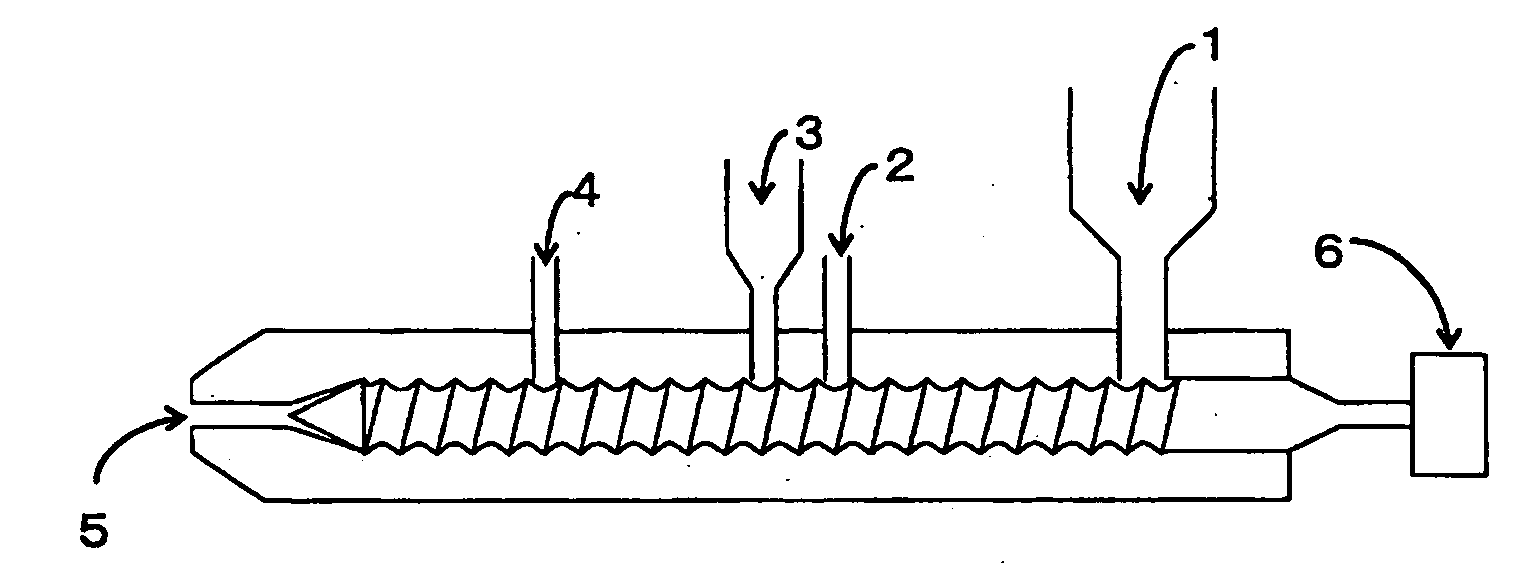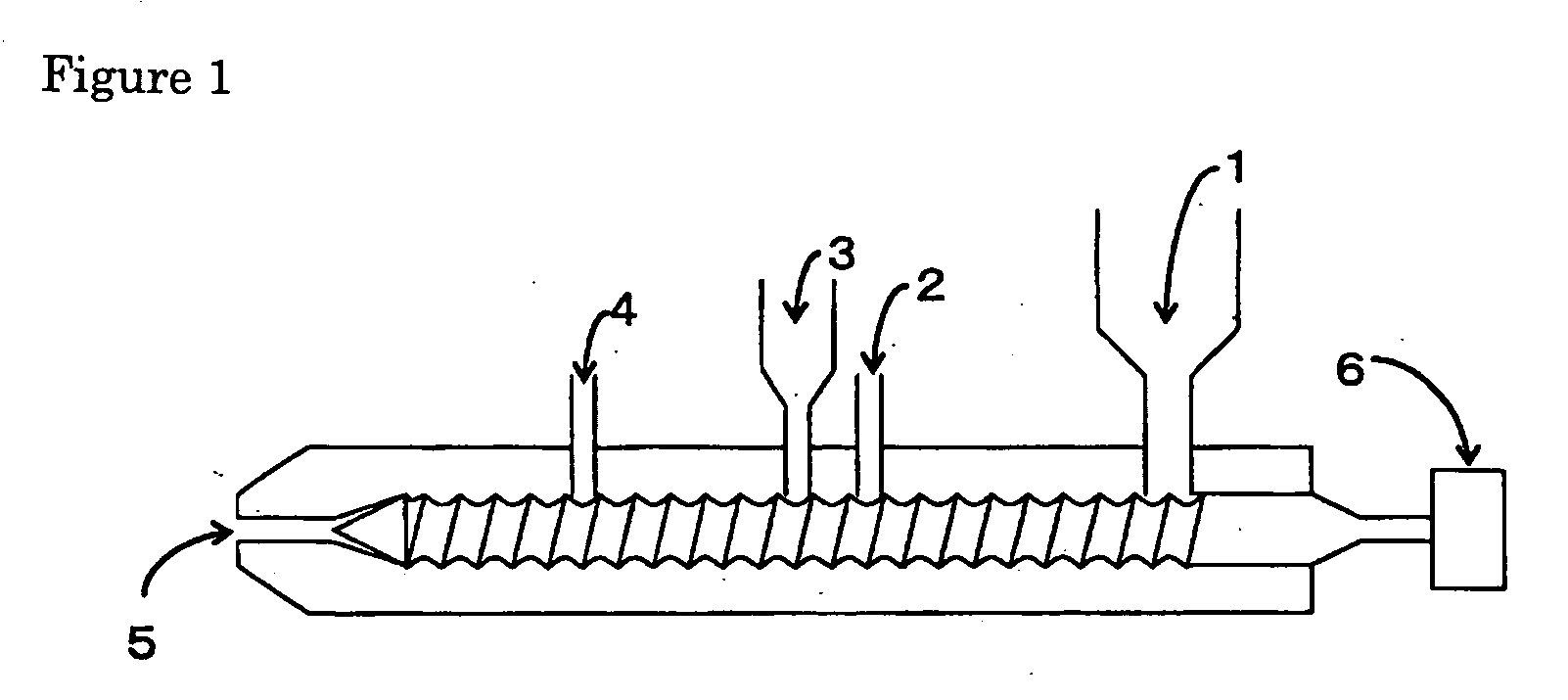Thermoplastic Resin Composition with High Thermal Conductivity
a thermoplastic resin and composition technology, applied in the direction of thermal insulation protection of pipes, mechanical equipment, pipe protection, etc., can solve the problems of difficult to allow generated heat to escape, plastics have a lower thermal conductivity, and the inorganic compound amount can be considerably reduced, and the composition is highly thermally conductive. , the effect of reducing the amount of inorganic compounds
- Summary
- Abstract
- Description
- Claims
- Application Information
AI Technical Summary
Benefits of technology
Problems solved by technology
Method used
Image
Examples
example 1
[0145](PC-1) and (PO-1) used as the thermoplastic resin (A) and (PES-1) used as the thermoplastic polyester resin (B) were mixed at a volume ratio of (PC-1) / (PO-1) / (PES-1)=30 / 1 / 30. One hundred parts by weight in total of both components and 0.2 part by weight each of Adekastab EP-22, Adekastab AO-60 and Adekastab HP-10 (all trade names, manufactured by Asahi Denka Kogyo K.K.) as stabilizers were mixed using a superfloater (raw material 1).
[0146]Separately, 100 parts by weight of (FIL-1) as the highly thermally conductive inorganic compound (C), 1 part by weight of a silane coupling agent A-187 manufactured by Dow Corning Toray Co., Ltd. and 10 parts by weight of ethanol were mixed using a superfloater, stirred for five minutes and then dried at 80° C. for four hours (raw material 2).
[0147]The raw material 1 was introduced from a hopper as a first supply port provided near the root of the screw in a co-rotating intermeshed twin-screw extruder TEX44 manufactured by The Japan Steel Wor...
examples 2 to 7
, Comparative Examples 1 to 5
[0149]An evaluation sample pellet was obtained in the same manner as in Example 1, except that the type and amount of the resins used were changed as shown in Tables 1 and 2. The raw materials were not introduced from the second supply port in Comparative Example 5.
[Moldability]
[0150]Melt viscosity of the resulting pellet was measured using a capillary rheometer manufactured by Toyo Seiki Seisaku-Sho, Ltd. at the same set temperature as the temperature during extrusion under the conditions where the preheating time was five minutes, the capillary size was 1 mmφ×10 mm and the shear rate was 608 sec−1.
[Measurement of Presence Ratio and Determination of Continuous Phase Structure in Highly Thermally Conductive Inorganic Compound (C)]
[0151]The resulting pellet having a diameter of about 3.6 mm was cut in the center to prepare an extremely thin section in the pellet center. The section was stained with ruthenium and then observed under a transmission electron...
example 8
[0158](PA-1) and (PO-2) used as the thermoplastic resin (A) and (PES-2) used as the thermoplastic polyester resin (B) were mixed at a volume ratio of (PA-1) / (PO-2) / (PES-2)=27 / 6 / 27. To 100 parts by weight in total of both components, 0.2 part by weight of a phenol stabilizer and 0.2 part by weight of a sulfur stabilizer were added as stabilizers, and (PO-2) as another resin was added after calculating to make the ratio of (PO-2) 6 vol % in the composition including the component (C). Thereafter, the components were mixed using a superfloater (raw material 3).
[0159]Separately, 100 parts by weight of (FIL-2) as the highly thermally conductive inorganic compound (C), 5 parts by weight of epoxysilane KBM-303 manufactured by Shin-Etsu Chemical Co., Ltd. and 10 parts by weight of ethanol were mixed using a superfloater, stirred for five minutes and then dried at 80° C. for four hours (raw material 4).
[0160]The raw material 3 was introduced from a hopper as a first supply port provided near...
PUM
| Property | Measurement | Unit |
|---|---|---|
| thermal conductivity | aaaaa | aaaaa |
| volume average particle size | aaaaa | aaaaa |
| volume average particle size | aaaaa | aaaaa |
Abstract
Description
Claims
Application Information
 Login to View More
Login to View More - R&D
- Intellectual Property
- Life Sciences
- Materials
- Tech Scout
- Unparalleled Data Quality
- Higher Quality Content
- 60% Fewer Hallucinations
Browse by: Latest US Patents, China's latest patents, Technical Efficacy Thesaurus, Application Domain, Technology Topic, Popular Technical Reports.
© 2025 PatSnap. All rights reserved.Legal|Privacy policy|Modern Slavery Act Transparency Statement|Sitemap|About US| Contact US: help@patsnap.com


